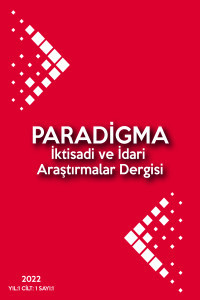BORSA İSTANBUL’DA YER ALAN SEKTÖR ENDEKSLERİ ARASINDAKİ OYNAKLIK YAYILIMININ ÇOK DEĞİŞKENLİ GARCH MODELİ İLE ÖLÇÜLMESİ
Oynaklıkların yayılma etkisi, finansal piyasaları etkileyen ve piyasadaki katılımcılar açısından oldukça önemli hal alan bir durumdur. Bir piyasada yaşanan oynaklık diğer piyasayı etkilemesi halinde risk oluşmaktadır. Bu durumda portföy yöneticileri ve yatırımcılar portföylerini korumak için bu riski minimize etmek isteyeceklerdir. Bu çalışmada Borsa İstanbul’un BIST Hizmetler ve BIST Mali sektör endeksleri kullanılarak aralarındaki oynaklık yayılımı analiz edilmiştir. Ayrıca kullanılacak olan Granger ve Hong Nedensellik testleri ile iki sektör endeksi arasındaki nedenselliğin yönü ve ilişkisi ortaya konulmuştur. Yapılan analizler sonucunda her iki sektör endeksleri arasında oynaklık yayılımının olduğu belirlenmiştir. Nedensellik analizleri testleri sonucuna göre her iki sektör endeksleri arasında çift yönlü bir nedensellik olduğu görülmüştür. Elde edilen sonuçlar gerek yatırımcılar gerekse portföy yöneticileri açısından risklerini azaltmak ve optimal portföy yönetimi yapmak için önemli olmaktadır.
Anahtar Kelimeler:
Sektör Endeksleri, Oynaklık Yayılımı, Hong Nedensellik
MEASUREMENT OF VOLATILITY SPILLOVER BETWEEN SECTOR INDICES IN BORSA ISTANBUL WITH MULTIVARIATE GARCH MODEL
The effect of volatility spillovers that affects financial markets is a very important situation for the participants in the market. When the volatility in one market affects the other market, the risk occurs. In this situation, portfolio managers and investors will want to minimize this risk in order to protect their portfolios. This study aims to analyse volatility spillover between BIST Services and BIST Financial sector indices of Borsa İstanbul. In addition, with the Granger and Hong Causality tests to be used, the direction and relationship of causality between the two sector indices were revealed. As a result of the analyses, it was determined that there was volatility spillover between the two sector indices. According to the results of causality analysis tests, it was shown that there was a bivariate causality relationship between the two sector indices. The results are important for both investors and portfolio managers to reduce their risks and to ensure optimal portfolio management.
Keywords:
Sector Indices, Volatility Spillover,
___
- AROURI, Mohamed El Hedi, Jamel JOUİNİ, Duc Khuong NGUYEN (2011), “Volatility Spillovers between Oil Prices and Stock Sector Returns: Implications for Portfolio Management”, Journal of International Money and Finance, 30, 1387-1405.
- AROURI Mohamed El Hedi, Amine LAHIANI, Duc Khuong NGUYEN (2013), “World Gold Prices and Stock Returns in China: İnsights for Hedging and Diversification Strategies”, https://hal.archives-ouvertes.fr/hal-00798038
- ÇAĞLI, Efe Çağlar, Fatma Dilvin TAŞKIN, Pınar EVRİM MANDACI (2014), “The Interactions between Oil Prices and Borsa Istanbul Sector Indices”, International Journal of Economic Policy in Emerging Economies, 7(1), 55-65.
- DICKEY, D. A. ve Wayne A. FULLER (1979), “Distribution of the Estimators for Autoregressive Time Series with a Unit Root”, Journal of the American Statistical Association, 74, 427-431.
- ENGLE, Robert (2002), “Dynamic Conditional Correlation: A Simple Class of Multivariate Generalized Autoregressive Conditional Heteroskedasticity Models”, American Statistical Association Journal of Business & Economic Statistics, 20 (3).
- GRANGER, C. W. J. (1969), “Investigating Causal Relations by Econometric Models and Cross-Spectral Methods”, Econometrica, 37, 424–438. doi: 10.2307/1912791.
- GOEIJ Peter ve Wessel MARQUERING (2009), “Stock and Bond Market Interactions with Level and Asymmetry Dynamics: An out-of-Sample Application”, Journal of Empirical Finance, 16, 318–329.
- HAESEN, Daniel, Patrick HOUWELING ve Jeroen Van ZUNDERT (2017), “Momentum Spillover from Stocks to Corporate Bonds”, Journal of Banking & Finance, 79, 28-41.
- HASSAN, Syed Aun ve Farooq MALIK (2007), “Multivariate GARCH Modeling of Sector Volatility Transmission”, The Quarterly Review of Economics and Finance, 47, 470–480.
- HONG, Yongmiao (2001), “A Test for Volatility Spillover with Application to Exchange Rates”, Journal of Econometrics, 103, 183-224.
- JONES, Paul M. ve Eric OLSON (2013), “The time-Varying Correlation Between Uncertainty, Output, and Inflation: Evidence from a DCC-GARCH Model”, Economics Letters, 118, 33–37.
- KIM, S. J., F. MOSHIRIAN, E. WU (2006), “Evolution of International Stock and Bond Market Integration: Influence of the European Monetary Union”, Journal of Banking & Finance, 30(5), 1507-1534.
- KOUKI Imen, Nizar HARRATHI, Mahfuzul HAQUE (2011), “A Volatility Spillover Among Sector Index of International Stock Markets”, Journal of Money, Investment and Banking, 22, 32-45.
- MALIK, Farooq ve B.T. EWING (2009), “Volatility Transmission Between Oil Prices and Equity Sector Returns” International Review of Financial Analysis, 18, 95–100.
- NARAYAN, Paresh Kumar, S. NARAYAN (2010), “Modelling the Impact of Oil Prices on Vietnam’s Stock Prices”, Applied Energy, 87, 356-361.
- PHILLIPS, P. C. B., ve P. PERRON (1988), “Testing for a Unit Root in Time Series Regressions”, Biometrika, 75, 335-346.
- TOKAT, Ekin (2010), “İMKB Sektör Endeksleri Arasındaki Şok ve Oynaklık Etkileşimi”, BDDK Bankacılık ve Finansal Piyasalar, 4 (1), 91-104.
- TSE, Yiu Kuen (2000), “A Test for Constant Correlations in a Multivariate GARCH Model”, Journal of Econometrics, 98 (1), 107-127.
- Yayın Aralığı: Yılda 2 Sayı
- Yayıncı: Gümüşhane Üniversitesi
Sayıdaki Diğer Makaleler
E-DEVLETİN YOLSUZLUĞU AZALTICI ETKİSİ: AMPİRİK BİR ANALİZ
KIRIKKALE BELEDİYESİ EMLAK VERGİSİ GELİRLERİ ÜZERİNE BİR ARAŞTIRMA
KONAKLAMA İŞLETMELERİNİN PAZARLAMASINDA MOBİL TEKNOLOJİNİN KULLANIMI
Alina POYRAZ, Hanifi Murat MUTLU
MUHASEBE BİLGİ KALİTESİNİN BOYUTLARININ İNCELENMESİ: BİR UYGULAMA
Fikret ÇANKAYA, Aykut KARAKAYA, Neslihan KELEŞ
Hatice Dilara KESKİN, Hüseyin Sabri KURTULDU
İNSAN HAKLARI NOKTASINDAN TÜRK ANAYASA TARİHİNDE İKİ ARA KESİT: 1876 VE 1961 ANAYASALARI
CDS PRİMLERİNİN MAKROEKONOMİK BELİRLEYİCİLERİNİN İNCELENMESİ: ARDL SINIR TESTİ YAKLAŞIMI
